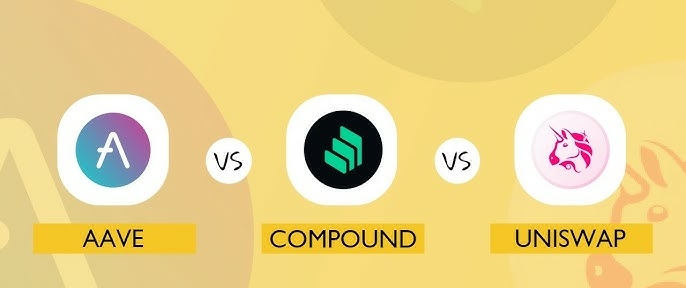Imagine walking into a bank.
The marble floors gleam, the air hums with quiet formality, and behind the counter sits the gatekeeper of your financial future. You’re here to ask permission—to borrow, to invest, or even just to hold your money.
Now imagine tearing down the walls of that bank and replacing it with a digital, borderless, and trustless system where the only thing between you and your financial freedom is a data connection.
This is DeFi: decentralized finance. It’s not just a tool—it’s a revolution. And it’s flipping the script on who controls money and how.
DeFi: The Foundation of a New Financial Order
At its core, DeFi is a set of financial tools and services built on blockchain technology, primarily Ethereum. It replaces banks, brokers, and middlemen with smart contracts—pieces of code that automatically execute agreements when conditions are met. These protocols operate with the precision of a Swiss watch, minus the human hand that can alter the outcome.
Want to borrow or lend? Platforms like Aave and Compound let you do it without pleading your case to a bank manager. Need to trade assets? Decentralized exchanges (DEXs) like Uniswap let you swap tokens directly with other users—peer-to-peer, no intermediaries.
These are not fringe applications. They’re the bedrock of a new financial system. It’s like upgrading from the postal service to email—instant, reliable, and unstoppable.
The Ownership Revolution: The People’s Financial System
In traditional finance, profits flow upward. Banks pocket the lion’s share of interest, fees, and spreads while you settle for scraps. DeFi flips this model on its head.

Through governance tokens—like UNI (Uniswap), COMP (Compound), or AAVE—users can own a piece of the very protocols they use. These tokens are more than assets; they’re your voice. Want to lower transaction fees or introduce new features? Token holders vote. It’s financial democracy in action.
But the real magic lies in the cash flow. Many DeFi platforms distribute a share of their earnings—transaction fees, interest, or staking rewards—to token holders. Imagine owning stock in Amazon and receiving a cut of every Prime membership fee. That’s the DeFi model.
And it’s not just about returns. By holding tokens, users become stakeholders in a system they believe in, aligning incentives and fostering collaboration.
Financing Infrastructure: Building the Backbone of DeFi
DeFi doesn’t just work—it grows. And it does so in a way that mirrors open-source software development.
Instead of venture capital or government grants, DeFi projects finance themselves through token offerings. Early supporters buy tokens, providing funds to develop infrastructure, hire developers, and conduct security audits. These tokens, in turn, gain value as the project succeeds, rewarding early adopters for their belief and risk-taking.
Take Yearn Finance, for example. It distributed its YFI tokens to early users who believed in its vision of automated yield farming. Those tokens now power a billion-dollar ecosystem.

This model creates a flywheel effect. Protocols reward users with tokens, users contribute liquidity and engagement, and the platform evolves, becoming more robust. The infrastructure grows not through gatekeeping but through community-driven innovation.
The Battle Against Traditional Finance
Let’s not mince words. DeFi is a direct challenge to traditional finance.
Picture this: you deposit $1,000 in your bank’s savings account. If you’re lucky, you’ll earn 0.5% interest annually. Meanwhile, the bank pushes a button. They multiply it by 10-20X and loan that amount out at 6% or more and pocket the difference.
Now, imagine taking that $1,000 and depositing it into a DeFi lending protocol like Aave. Suddenly, you’re earning 5%—directly. No marble floors. No gatekeepers. Just you, the protocol, and the blockchain.
DeFi doesn’t just cut out the middleman. It replaces the entire structure with a competitive marketplace. If one protocol falters, another steps in with better yields, faster transactions, or lower fees. It’s capitalism at its purest—a system where innovation thrives, and inefficiency dies.
Risks and Responsibilities
But with great power comes great responsibility. DeFi users must navigate risks, including smart contract vulnerabilities, market volatility, and regulatory uncertainty. This isn’t a playground—it’s a frontier.
Unlike traditional finance, where banks protect (and often limit) your actions, DeFi puts the reins in your hands. That means taking precautions: storing assets securely in hardware wallets, diversifying investments, and understanding the protocols you engage with.
A Vision for the Future
DeFi isn’t just about making money. It’s about making a difference.
In regions plagued by hyperinflation or financial censorship, DeFi offers a lifeline. It allows anyone, anywhere, to access stable currencies, earn yields, and transfer value without interference. It’s already changing lives in countries like Venezuela and Nigeria, where traditional banking systems have failed.
But DeFi’s potential doesn’t stop there. By financing its own development, DeFi is laying the groundwork for Web3—a decentralized internet where users own their data, their identities, and their online interactions.
DeFi Is Freedom
DeFi isn’t perfect, and it isn’t risk-free. But it’s a glimpse into what finance could—and should—be.
It’s a world where access isn’t a privilege but a right. Where users don’t just use financial services—they own them. And where innovation builds infrastructure that benefits everyone, not just the few.
So, whether you’re an investor, a developer, or simply curious, dive into DeFi. Experiment with protocols. Stake some tokens. Be part of the revolution.
Because the future of finance isn’t something you wait for—it’s something you own.
Technical Analysis
As of November 19, 2024, here’s a concise technical analysis of the cryptocurrencies mentioned above based on TradingView data:
Bitcoin (BTC): Currently trading at $92,316, Bitcoin has broken above its 200-day moving average, indicating a potential bullish trend. The Relative Strength Index (RSI) is approaching overbought territory, suggesting caution for new entries.

Ethereum (ETH): Ethereum is trading at $3,104.06, having recently surged to a three-month high. The breakout above the descending channel, accompanied by high trading volume, signals strong bullish momentum. However, the RSI above 70 indicates overbought conditions, which could lead to short-term fluctuations.

Uniswap (UNI): Uniswap is exhibiting a potential reversal pattern against Bitcoin, with recent price action suggesting a bullish divergence. The formation of a falling wedge pattern indicates a possible upward breakout, though confirmation is needed.

Compound (COMP): Compound is showing signs of consolidation after a recent uptrend. The price is hovering around key support levels, with the RSI in neutral territory, indicating a balance between buying and selling pressures.

Aave (AAVE): Aave has experienced a significant 44% increase over the past four weeks, outperforming major cryptocurrencies. The price is currently testing resistance levels, and a successful breakout could lead to further gains. However, traders should monitor for potential pullbacks due to overextended conditions.

Please note that cryptocurrency markets are highly volatile, and technical indicators should be used in conjunction with other analyses and risk management strategies.



